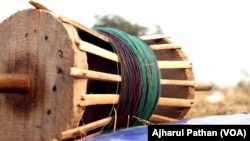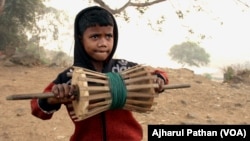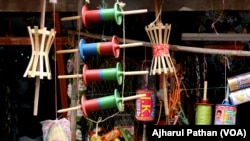India’s annual kite-flying competition turned deadly this year as competitors used specially-coated strings to disable their opponents kites.
Police say six people were killed in the Indian state of Gujarat during the January 14 festival after their throats were sliced by glass-coated kite strings.
Three children, including a two-year-old baby, were among those killed after the glass-encrusted razor-sharp strings—used by “kite fighters” participating in the Uttarayan festival—got entangled around their necks and slit their throats.
As thousands of mostly young revelers across different districts of the state flocked to open fields and rooftops during the festival and flew their kites toward the sky, at least 176 people also got injured by the strings and falls from the high vantage points, Gujarat police reported.
While flying kites, fighters often engage in a type of aerial combat, attempting to slice the kite strings of rivals with their own. During these fights, the strings sometimes swing closer to the ground or get entangled on trees and electrical poles, sometimes causing accidents like those that took place in Gujarat.
Traditionally, kite strings were made of cotton threads. But in recent years, Indian kite fighters have been using sharp nylon or synthetic strings coated with powdered glass called Chinese manjha — Chinese string, in Hindi — that is almost exclusively made in India. Manjha, which originated in China, does not break easily.
In the Gujarat city of Bhavnagar, Kirti Thakur, a 2-year-old girl was riding on a scooter with her father when a dangling kite string wrapped around her neck. The string penetrated even deeper when the father tried to remove it. She died in the hospital a day later.
A 3-year-old girl identified only as Kismat was walking with her mother when a kite string struck her neck and slit her throat. She died on the way to the hospital.
A week after the festival, Gujarat Police reported that all those killed and injured in the festival were struck by manjha.
Illegal
Manjha has been banned in India since 2017, and anyone caught selling or using the killer string faces fines of up to 100,000 rupees ($1,230) and jail terms of up to five years. Beyond police raids targeting manjha sellers, the ban is rarely enforced.
Despite the stiff penalties, usage remains widespread, especially by young people during kite-flying season and festivals.
Muthupandian Palanisamy, a Chennai-based animal welfare activist, say it is possible that manjha kills or injures thousands of birds annually.
“When they fly into the Chinese manjha, [the] kite strings, they cause deep gashes to their wings, necks and legs. Often, they fall on the ground with their injuries and become immobile,” Palanisamy told VOA. “Rarely [does] a bird happen to receive emergency treatment for its injuries, and in many cases, they die eventually.
“The police usually register human injuries or deaths caused by the kite strings, but rarely the injuries or deaths of wild birds are properly kept track of in India,” he added. “There is no doubt that thousands of birds get injured by the killer kite strings.”
Many locals say it is difficult to put a stop to manjha’s use in India.
“You can get Chinese manjha everywhere in India,” said Kruti Desai, a teacher in Surat, Gujarat. “They are available in underground markets across the country, in cities, small towns and even villages. One can also buy it online.
“Every year, Chinese manjha is killing dozens of people and an unknown number of birds in India,” she added. “There must be stricter police surveillance, enforcing the ban on this killer string.”














